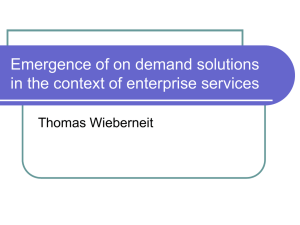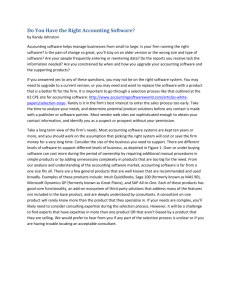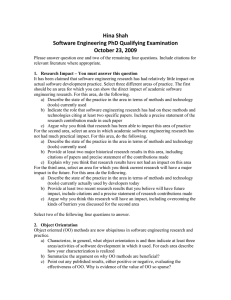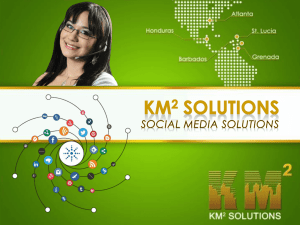The Journey to SaaS Profitability Four considerations for software
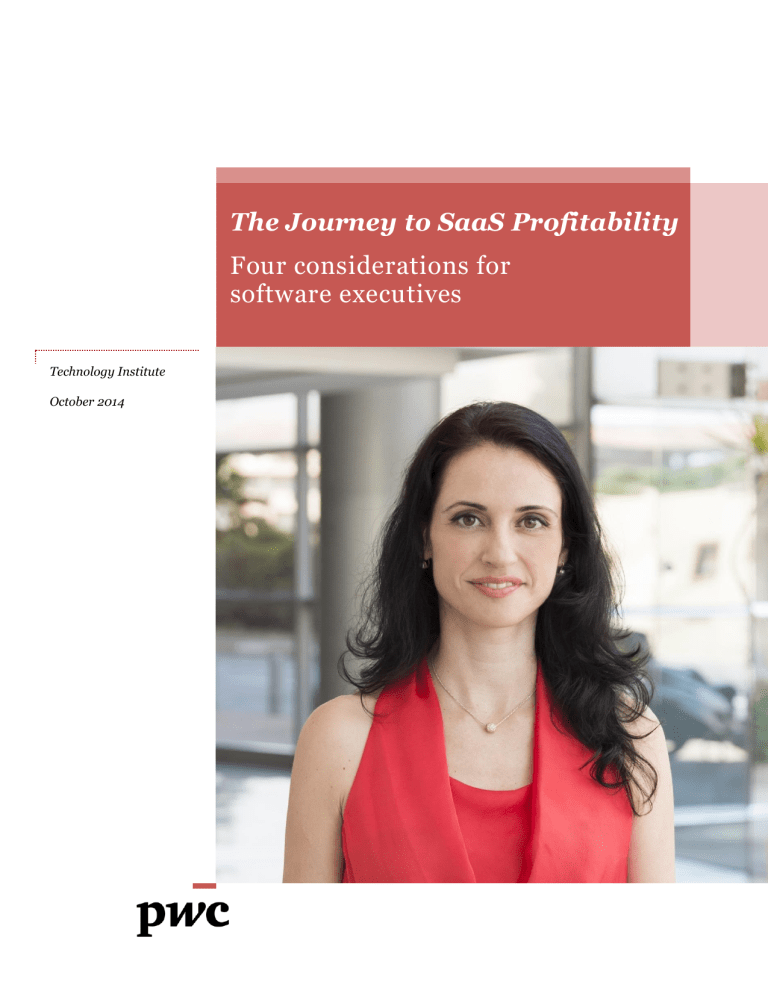
Technology Institute
October 2014
The Journey to SaaS Profitability
Four considerations for software executives
For SaaS providers, the journey to profitability is filled with challenges: Is your company ready?
Highlights
Software providers moving from on-premise to SaaS offerings can expect major disruptions to the company’s operating model requiring:
Expanded revenue model and new profitability drivers
New operational and technical requirements
SaaS exposes your company to a new world of enterprise risk considerations, especially if your company is also offering “on- premise” software
The role of the CIO needs to shift to become much more customerfacing requiring significant organization and cultural changes
Start preparing now as the complexity of your operations will only increase
Software-as-a-Service (SaaS) is driving increased operating model complexity and disruption in the software industry.
Instead of selling their software to customers to run on-premise, software companies offer “Software- as-a-Service” by running and operating the software on behalf of their customers. This typically requires them to offer 24/7 online purchasing capabilities, on-demand provisioning and on-going support… while getting paid only as service is consumed. While this gives customers more economic value by balancing their utilization needs – it increases the focus on managing cost and complexity for the vendor.
Traditionally, the mature software industry has been marked by a steady, single digit Compound Annual
Growth Rate (CAGR). However, SaaS companies are experiencing doubledigit growth and disrupting the industry so much so that traditional software companies are looking at offering SaaS: 82% of net new commercial applications are built specifically for cloud delivery. Looking forward, $1 of every $5 spent on applications will be consumed via
SaaS by 2016.
1 So what does all of this mean?
As customer demand mounts in the market place, more companies are now focusing R&D efforts on cloud computing paradigms. Their reasons for moving to this model are varied: more market share, better relationships with customers, faster sales cycles, new market segments,
R&D cost reduction or licensing simplification. The drivers for a business model change to SaaS are varied – and the one constant is massive change and disruption to a company’s operating model.
1 IDC: The Coming of the 3rd Platform and What this
Means for Software Business Models, Doc #240918,
May 2013
Where might your company feel impact?
1.
Operating Model Changes.
Independent Software Vendors
(ISVs) need to transform their operating model around a new set of Lead to Cash (L2C) capabilities that orient around a new customer experience. Executives should recognize the difficulty, level of complexity and commitment involved and understand where others have succeeded or failed.
2.
New Profitability Levers.
Your performance management processes will require changes.
SaaS requires a “consumption based” economics approach with a greater emphasis on key metrics such as Committed Monthly
Recurring Revenue (CMMR) and
Customer Acquisition Cost (CAC) among others.
3.
Technology.
Many companies are managing both an on-premise and SaaS environment (hybrid).
This reality introduces inherent challenges of straddling two unique business models. The role of the CIO is being stressed like never before.
4.
Risk and Compliance.
SaaS introduces a new world of additional complexity and risks. As such, companies need to place an increasing priority on developing strong internal control activities; incorporating them into their existing governance programs.
1 Overview
Driving profitability in a SaaS business model requires major structural changes around a new set of operational capabilities:
More Personalized Sales:
Shifts towards recurring revenue growth and on lowering customer acquisition costs.
Data Analytics:
Significantly more emphasis on consumer analytics and personalized campaigns
Real Time Enterprise
The priorities of IT shift as more demand is placed on availability, quick time to value, and real time usage analytics and insights.
SaaS Product
Development
Becomes more about the experience and consume ability vs. a feature pile on
New Support Models
Shifting emphasis away from product expertise to driving usage and customer success
Consumption Economics
A new set of demand forecasting and revenue recognition requirements such as usage based billing
At a glance 2
Ensure your company’s operating model is oriented around a new customer experience
Channel Convergence
The traditional software channels of reseller and value-added reseller, retail, and OEM are changing. Is your channel strategy aligned?
IDC predicts that by the end of 2014
30% of net-new business software purchases will be made through an online marketplace operated by an
ISV or third party.
2 eCommerce and Mobility
The mobile channel is expected to erode the importance of ecommerce as the leading digital channel for multichannel retailers.
By 2017, slowing growth rates in ecommerce revenue will mean this channel will account for no more than 25% of overall retail revenue for leading multichannel retailers.
3
Sales and Marketing
Traditional software providers focused on large, one-time transactions, and were also focused on penetration of large accounts. In the
SaaS model, initial revenue might be low – but should ideally increase over time. This means that SaaS sales organizations need to drive recurring revenue growth and optimize customer acquisition cost (CAC).
Moreover, account growth also depends on a stronger partnership
2 IDC, The Coming of the 3rd Platform and What this
Means for Software Business Models, doc #240918,
May 2013
3 Gartner, Predicts 2014: Digitalization in Retail Means
M-Commerce Grows, E-Commerce Slows,
Personalization Misfires and 3D Printing Transforms,
November 2013 with the support organization – to keep the cost of sales/renewals low. As the trend of online marketplaces continues to accelerate and SaaS increases its penetration into new segments, the sales organization also needs to modify its channel strategy.
Marketing executives now have a premium placed on “real time” customer experience analytics. Data analytics on usage and the customer experience are critical to driving personalized campaigns, whereas traditional ISVs focused on large, broad marketing campaigns.
Product Development
In the SaaS world, even though providers are leveraging the same platform for multiple clients, successful vendors are able to channel client feedback on the product’s weaknesses and strengths rapidly into
R&D and production operations.
Therefore frequent release cycles are a critical component of a SaaS business.
Moreover, in the SaaS world, if the product does not perform, customers will simply not stay. Frequent release cycles are a means to address historical insight complexities such as: add functionality to make customers happy, or run the risk of losing them.
CIOs must actively re-think their software development lifecycles and transform them to enable greater customer centricity.
Finance and Business
Operations
SaaS profitability remains a key challenge for many companies.
Customer acquisition costs are high and payback periods can be years out.
The CFO and COO organizations need to ensure that transactions are evaluated real time (vs. predetermined reporting periods) and that a more nimble Lead to Cash capability supports this. Companies need to forecast demand impacting
CAPEX and COGS run rate. They also require subscription or transaction based agreements and a new way of recognizing revenue.
Technology
Companies that run a hybrid environment face the burden of managing multiple infrastructures.
Unlike traditional on-premise licenses, the SaaS model has much heavier customer touch points with more frequent interactions. Given the frequent release cycles with SaaS, IT needs to ensure consistent availability with non-disruptive upgrades and continued interoperability.
Also, IT has a much greater ability to partner with the business and provide real-time feedback to R&D and product marketing teams… if they are capturing the right data. Sentiment analysis through digital and social channels can provide a treasure of market insights. Usage-based monitoring and feature-based metrics provide insights into consumer patterns.
3 Ensure your company’s operating model is oriented around a new customer experience
Are you ready for a new profitability dynamic?
Metrics Matter
The key levers of operational profitability change when a company moves from a traditional, on-premise model to a SaaS model
To lower the average Sales and
Marketing cost for customer acquisition, focus on channel optimization and reducing the length of the sales cycle. Actively measure and manage customer engagement to accelerate payment time. Automation can drive cost takeout as well.
2. Increase Committed Monthly
Recurring Revenue (CMRR)
Renewal
Customer
Churn
Rate
SaaS Objective 101
In addition to standard profitability metrics (e.g. EBITDA), here are 5 metrics that are central to a SaaS company’s operating model.
CAC is often the largest expense for
SaaS companies and a key indicator for profitable growth.
Most software vendors want new
(large) enterprise customers.
Unfortunately, acquiring them requires tremendous efforts from marketing, sales, training, account management teams and so forth. All of these teams need to carefully orchestrate a value proposition that is differentiated. Compound this issue with more SaaS choices for consumers
-- and the difficulty of customer acquisition increases.
This is often the best growth indicator for a SaaS company, as this metric provides a pipeline view by measuring
Monthly Recurring Revenue (MRR) + signed contracts. It helps differentiate between “one time” fees and recurring fees; and in identifying churn.
To maximize CMRR, your firm will want to drive competitive pricing and offers in the marketplace. Also, projects that optimize sales channels should be prioritized.
Engineering your operations to drive these is an essential first step in driving SaaS profitability.
1. Lower Customer Acquisition
Cost (CAC)
3. Optimize Churn/Renewal Rate
Your customer renewal rate serves as a key indicator of the value of your company’s annuity stream. The importance of a strong customer experience plays a critical role here.
With SaaS, vendors face a new and empowered customer who wants consumption-based pricing and has the ability to opt out monthly.
Customers can select pay per usage
(PPU) options, and due to a more flexible and frequent enterprise agreement, are more empowered to provide feedback on a regular basis.
Customer can also elect to leave altogether.
4. Increase Customer Lifetime
Value (CLTV)
The profitability and financial health of a software vendor can come by understanding the present value of a customer. This is an important metric, as it serves as a leading indicator of operational efficiency.
In simple terms, ensure your CLTV >
CAC. If you spend more time reducing churn and enhancing the customer experience, the lifetime value will increase. Moreover, you will want to find ways to reduce acquisition costs.
5. Maximize Free Cash Flow
Perhaps the most obvious, Free Cash
Flow (FCF) is a critical metric for SaaS companies. There are obvious cash flow problems with subscription models as companies spend upfront to acquire customers and recognize revenue slowly over a period of months. The time to recover the CAC results in negative cash flow during that period, stressing operations.
Are you ready for a new profitability dynamic? 4
Evolve the role of the CIO to be more consumercentric
What it means for your business:
SaaS business models are oriented around a new Lead to Cash (L2C) lifecycle that is much more consumer-centric. Technology needs to enable this new dynamic.
-----------------------------------------
Sales channels are changing as online marketplaces and app stores are becoming much more prevalent.
Is your IT organization proactively building teams to manage these?
-----------------------------------------
The role of the CIO needs to evolve from managing assets to be a chief
“orchestrator” of product innovation.
A new Lead to Cash (L2C) lifecycle pivots around an empowered customer. Is your technology strategy ready?
The “North Star” for software companies is a unified, seamless customer experience with targeted offers and sustained profitable growth. The challenge companies have is transforming their L2C processes to enable this. Consider the following questions:
What are your customers willing to pay?
When it comes to SaaS pricing strategies, enterprises should have a keen focus on strategic levers such as, operating margins, freemium/trials, and appropriate sales incentives and commission structures.
How do your customers buy?
In the near term, SaaS cycles often create additional sales motions (vs. reducing them). Optimize your selling motions and leverage new and emerging channels (online marketplaces, mobile) to drive share growth.
How do customers consume your services and what are they entitled to?
Not only do companies need to meter and measure for services provided, they also need to enable strong order management and fulfilment processes.
How do customers pay for your services?
Consumption-based economics are new to many organizations. The first matter that needs to be developed are new billing and revenue recognition models that allow for transparency into usage patterns with real-time monitoring that is tied to billing activities. Billing in this new model needs to align with accounting practices (e.g. FASB).
New customer experiences are changing technology requirements
A new reality for CIO’s: Business units increasingly circumvent IT as barriers to technology adoption fall; when uncoordinated, this raises costs, increases risk and fragments data.
After all, why go through IT when business units can often procure the same technology faster and cheaper elsewhere? By the end of 2016, 40% of all IT sales will be decided by the line of business executive.
4
So how does the CIO stay relevant? By evolving to a customer facing
“orchestration role” and leading with experience and analytics to enable product innovation. The days of providing IT infrastructure and operations support are over.
Evolving Infrastructure and Delivery
Requirements:
CIOs must address incremental dynamics.
Application availability and nondisruptive upgrades are central to
SaaS effectiveness
Faster software development lifecycles
Usage analytics and user insights are essential
Usability and quick time to value.
SaaS customers have choices and can opt out, so an IT organization needs to be agile.
Managing two infrastructures
(on-premise + SaaS) creates the need for separate talent and processes and a greater ability for the CIO to manage cost and complexity
4 IDC, The Coming of the 3rd Platform and What this
Means for Software Business Models, doc #240918,
May 2013
5 Evolve the role of the CIO to be more consumer centric
Are you ready for a new set of strategic and compliance risks?
48% of application producers don’t have the technology in place to know what product version or platform their customers are using 5
-----------------------------------------
SaaS brings with it the burden of additional complexities in managing risks for software providers
-----------------------------------------
“Adding better software enforcement and security” ranked
#2 on a recent IDC survey of CIO’s regarding expected changes in software licensing 6
SaaS profitability requires a strong understanding of new risk dynamics and complexities
According to Gartner, “by 2019 cloud computing and the new digital economy will cause subscription pricing to overtake perpetual licensing and maintenance.” 7 For SaaS providers, this is obviously a promising trend; however, it comes with inherent risks that need to be understood and proactively managed.
The complexity of SaaS and the reality that most large companies employ a hybrid model further demonstrates the need to understand risks.
5 Flexera Software, 2012 Key trends in Software Pricing and Licensing Survey
6 IDC, IT Buyer Market Guide: Software Licensing and
Provisioning, doc #242279, August 2013
7 Gartner, Predicts 2014: The Digital Economy and the
Cloud Raise New Licensing, Services and ITAD
Challenges for ITAM and Procurement, November
2013.
Software executives must begin to address several new dynamics. Here are a few examples:
Information Security and Data
Privacy: From user access to encryption to source code access, the list of security risks can be extreme. Reputational risks (not to mention financial and operational risks) depend on a strong security program. Architecture security considerations are also essential.
Data Resiliency and Disaster
Recovery: By hosting your client’s most sensitive data, you assume the risk (and financial liability) of either losing or mishandling it.
Physical access controls, data center selection and resiliency programs are just a few examples of major considerations for SaaS providers.
Compliance Risks : Ensure your
SaaS processes are in compliance with existing and emerging regulatory requirements IFRS,
ISO, SOC reporting and new revenue recognition standards are among requirements that should be considered.
Consumer-Centric Risks : This is perhaps the single most import set of risks faced by SaaS companies as a premium is placed on attracting and retaining customers.
“Experience” risks are vast but can be mitigated by strong planning beginning with customer requirements. Do you have capacity or other performance issues? Is your support organization delivering a strong experience? Do you support your client’s mobile devices?
Finally, as enterprises begin considering the use of cloud, the following questions should be considered prior to making a determination on your SaaS provider:
1.
How will assurance be provided to
SaaS cloud customers over metering of usage and billing integrity?
2.
How are you ensuring logical segregation of multiple customers' data in both live processing environments and backup/off-site storage environments?
3.
What types of controls or procedures are in place to ensure that sensitive client data is retained/destroyed in a secure manner?
4.
What types of authentication mechanisms do we have that restrict each customer's access to their own data?
Are you ready for a new set of strategic and compliance risks? 6
PwC can help
The journey to profitability is fraught with challenges. To successfully meet these challenges head on:
Ensure your operating model clearly supports and enhances a new and increasingly-demanding customer experience;
Take stock of your performance management processes and ensure you’re measuring the right metrics to drive better customer retention and a lower customer acquisition cost;
Ensure your IT organization and the role of the CIO is clearly supporting a new set of Lead to Cash (L2C) processes that represent fundamental changes from the status quo; and
Manage shareholder expectations accordingly.
Finally, prepare for a new set of strategic and operational risks that pose real-time challenges to your SaaS objectives.
For a deeper discussion about Software-as-a-Service, please contact one of our practice leaders:
Mike Pearl
Global Cloud Computing Leader
(408) 817 3801 michael.pearl@us.pwc.com
Let’s talk
Patrick Pugh
US Software and Internet Advisory Leader
(206) 398 3008 patrick.pugh@us.pwc.com
Please reach out to any of our technology leaders to discuss this or other challenges. We’re here to help.
Tom Archer
US Technology Industry Leader
408 817 3836 thomas.archer@us.pwc.com
Cory Starr
US Technology Assurance Leader
408 817 1215 cory.j.starr@us.pwc.com
Kayvan Shahabi
US Technology Advisory Leader
Diane Baylor
US Technology Tax Leader
408 817 5724 kayvan.shahabi@us.pwc.com
Acknowledgements
408 817 5005 diane.baylor@us.pwc.com
The following PwC professionals contributed their experience and knowledge to produce this paper.
Jonathan T. Finch
Technology Sector Director
Jasmin Young
Technology Sector Director
(858) 405 8792 jonathan.t.finch@us.pwc.com
(408) 221 5588 jasmin.young@us.pwc.com
About PwC’s Technology Institute
Eric Tan
Technology Sector Director
(857) 413-7594 eric.tan@us.pwc.com
The Technology Institute is PwC’s global research network that studies the business of technology and the technology of business with the purpose of creating thought leadership that offers both fact-based analysis and experience-based perspectives. Technology Institute insights and viewpoints originate from active collaboration between our professionals across the globe and their first-hand experiences working in and with the technology industry. For more information please contact Tom Archer, US Technology Industry Leader.
© 2014 PricewaterhouseCoopers LLP. All rights reserved. PwC refers to the United States member firm, and may sometimes refer to the PwC network.
Each member firm is a separate legal entity. Please see www.pwc.com/structure for further details.
